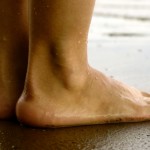Running Injury Free
Week #2

Keep your ankles loose!
Most (but not all) runners over the years have at one point in time had to deal with an injury. Typically, but not always, injuries stem from bad running form (poor biomechanics), trying to run too far, too fast (overtraining), or sometimes wearing a shoe that works against your unique biomechanics and stride.
Hence, the first blog on proper running form. The right running form, combined with a gradual, slow buildup of miles and/or intensity will safeguard you from experiencing running injuries.
I know. I have been running for ten years at a very gradual buildup, and my first (and only) injury was last year when I did something stupid. More about that later.
The reason I am telling you this is that you can completely avoid injuries if you are smart about your training. So I can’t stress enough how critical it is that you keep working on your form, and stick to the schedule, which plans you to build up your mileage gradually over time, and even has you running three miles before the actual race!
Sometimes, though, injuries can happen. The good news is that if you catch them early and treat them, they are only slightly bothersome. The bad news is that if you ignore them and don’t treat them, they will likely get worse, and you could find yourself not being able to run for awhile.
One word before I get into injuries: Being sore is NOT being injured. When your muscles are sore from a workout, it just means you’ve asked them to do more than they are used to. And they are adjusting. Soreness is to be expected, as I wrote in my first email. And soreness can come at any time.
Say you’ve plotted out a nice 1 mile run, nice and level, not a lot of hills. Now, your coach has asked you to make sure you run hills this week. You do, and your quads are sore. No surprise. In fact, I would be surprised if you’re NOT sore.
When your muscles are sore, take some time to stretch, massage, and soak. (Who doesn’t want to soak in a hot tub, I ask you?). OK back to injuries, which I really don’t anticipate to be a problem.
Here are 3 common runner’s injuries and how to prevent them: For more reading on this subject, I recommend this article:
1.Runner’s Knee. This is soreness in the knee area, around the knee cap, and it usually results from poor running form. It can also be made worse from too much hill work or a shoe that doesn’t fit.
Solution: If you are feeling pain in your knee, go back to Blog entry #1 and work on your form. Then go to a specialist in running shoes and make sure you’re not making do with the wrong shoes.
2. Shin Splints. Shin splints are an inflammation of the tendons that attach the front of the shin bone to the outside. It begins as a dull ache on the outside of your shin bone as you run and can get worse until it is painful to walk. Shin splints usually happen because you went out too fast, too far. Shin splint are the ONLY injury I have ever had as a runner, and it was purely the result of ego in a race, wanting to run faster, when I knew I shouldn’t.
Solution: Take it easy. Again, make sure you are running relaxed, and don’t get caught up in the excitement of the moment. That’s the best way to avoid shin splints. If you feel soreness, place an ice pack on the sore area right after your run. You can definitely run through shin splints, just take care and listen to your body.
3.Plantar Fasciitis. I’ve never had this, but I understand it can be very painful. You wake up in the morning, get out of bed, and the minute your feet hit the ground, there’s a pain running from just behind your toes to your heal. Tight calf muscles (i.e. hill running w/o stretching) can lead to plantar fasciitis. Usually the worst pain is when you get out of bed; however, once you start running (or walking), the pain will go away.
Solution: Again, don’t start doing hill work that’s too intense. If possible, when you sleep, keep your feet extended (toes to your bedroom door. Try to keep your feet from curling up during sleep, which aggravates the problem.
OK, now it’s time to fess up on my own injury, and why I could have avoided it. I am sharing this because 1) it was completely avoidable and 2) I don’t want you to make the same mistake.
Last year, a few weeks after the Boston Marathon (in which I had NO injuries,) I was in Maryland visiting my sister. She was helping to run a 5K to raise money for her neighborhood pool. She said to me (and I won’t forget this) “Hey Trish, your brother won in his age group last year and made it in the paper. Wouldn’t it be cool for you to win this year in your age group too?”
The challenge was out there. She was not running. And I was coming off Boston. But I thought somehow the Cunningham (my maiden name) legacy was at stake.
The race was in her (very hilly) neighborhood, and it consisted of about 5 switchbacks up and down side streets. I have to admit: Going in, I felt like a rock star: the sister from BOSTON that finished the Boston Marathon.
That was my downfall.
What I didn’t realize was that there were neighbors – women neighbors – who were out there defending their hard-earned title. And no outsider from Boston was going to trump that.
We started out fast – and ended faster. I swear I tasted blood in my lungs, I was running faster than I ever had. I passed these women; they passed me. I honestly hated the race while running, because it wasn’t fun. It was REALLY hard – too hard/ and for what? Funds to pay for the lifeguards at a pool that was 360 miles away from me?
I came in second in my age group by 4 seconds. I had run the fastest 5K I could ever even imagine. Sure, it felt (mentally) good to run sub-eight-minute miles and finish in 22 minutes. But it was brutal. And honestly? I’m glad the neighbor-contender laid her claim of first place. After all, it was her neighborhood and her pool. I think it would have been a shallow victory if I had won.
After that race, I nursed a shin splint for three months. It didn’t stop me from running. I would go out and then ice my ankle after every run. And it eventually went away. But I learned a valuable lesson. And if you have read this far, this is the most important advice I can tell you: Don’t run this race for time. Don’t run it for prestige. And don’t let your pride get the best of you.
Run your own race. And be happy you did it your way. There’s a lot of healing in that 🙂
 My professional experience includes leading the creative efforts of three companies I have co-owned. I'm a seasoned copywriter/creative director, award-winning journalist, avid runner, and mom of four. Got a story idea you'd like to share? Email me at treske@nowspeed.com. You can also find me on Twitter: @trishreske, LinkedIn and Facebook.
My professional experience includes leading the creative efforts of three companies I have co-owned. I'm a seasoned copywriter/creative director, award-winning journalist, avid runner, and mom of four. Got a story idea you'd like to share? Email me at treske@nowspeed.com. You can also find me on Twitter: @trishreske, LinkedIn and Facebook.
very good post! if you want to help your readers get a grasp on how to choose a running shoe, or to find the best reviews of the newest running shoes – our website is perfect for runners who want to find the running shoe that’s best for them!
hope you will visit us !